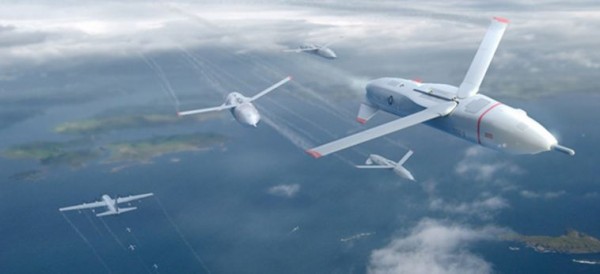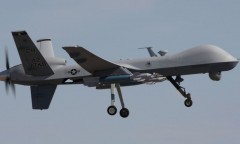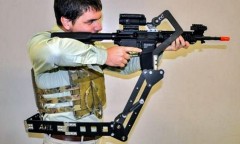By Arthur Dominic J. Villasanta , | March 30, 2017

Gremlins UASs.
The U.S. Defense Advanced Research Projects Agency (DARPA) is pushing forward with a program to develop swarms of recoverable aerial drones that will be launched from airborne "aircraft carriers" such as the Lockheed C-130 Hercules turboprop military transport or the Boeing B-52 Stratofortress.
Like Us on Facebook
This DARPA program called Gremlins envisions launching groups of unmanned aerial systems (UASs) from large aircraft such the C-130 and the B-52, as well as from fighters such as the McDonnell Douglas F/A-18 Hornet multi-role fighter while those planes are out of range of enemy defenses.
When the UASs, which DARPA calls gremlins, complete their mission, the aircraft carrier or mother aircraft from which they were launched will retrieve them in the air and carry them home. Ground crews will then prepare the Gremlins for their next use within 24 hours.
The Gremlins' expected lifetime of about 20 uses could provide significant cost advantages over expendable systems by reducing payload and airframe costs and by having lower mission and maintenance costs than conventional platforms, which are designed to operate for decades.
"For decades, U.S. military air operations have relied on increasingly capable multi-function manned aircraft to execute critical combat and non-combat missions. Adversaries' abilities to detect and engage those aircraft from longer ranges have improved over time as well," said DARPA.
DARPA is advancing Gremlins to the next phase of development, an effort which will involve initial testing and evaluations along with a Preliminary Design Review.
The Pentagon is also looking at other and smarter UASs to confuse the enemy on the battlefield.
The Pentagon's Strategic Capabilities Office has demonstrated an ability to launch small but expendable "Perdix" aerial microdrones from the flare dispenser of a General Dynamics F-16 air superiority fighter.
The test on Jan. 8 over Naval Air Station China Lake in California showed off Perdix's collective decision-making, adaptive formation flying and self-healing abilities without human intervention, said the U.S. Department of Defense.
During the demo, the Perdix drones collectively decided one mission had been accomplished. They then flew on to the next mission and carried out that one.
The benefit of a swarm is that if one drone or more crash or fail to deploy, the remainder can rearrange themselves to maintain coverage.
Perdix microdrones are ejected from flare dispensers of U.S. Air Force warplanes such as the General Dynamics F-16 and the McDonnell Douglas F/A-18 Hornet. They fall to earth, deploy their folded twin wings and assume a formation to attain the goal they're programmed to accomplish.
-
Use of Coronavirus Pandemic Drones Raises Privacy Concerns: Drones Spread Fear, Local Officials Say

-
Coronavirus Hampers The Delivery Of Lockheed Martin F-35 Stealth Fighters For 2020

-
Instagram Speeds Up Plans to Add Account Memorialization Feature Due to COVID-19 Deaths

-
NASA: Perseverance Plans to Bring 'Mars Rock' to Earth in 2031

-
600 Dead And 3,000 In The Hospital as Iranians Believed Drinking High-Concentrations of Alcohol Can Cure The Coronavirus

-
600 Dead And 3,000 In The Hospital as Iranians Believed Drinking High-Concentrations of Alcohol Can Cure The Coronavirus

-
COVID-19: Doctors, Nurses Use Virtual Reality to Learn New Skills in Treating Coronavirus Patients










